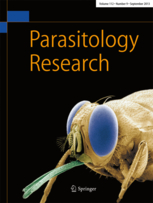Efficacy of a chlorocresol-based disinfectant product on Toxocara canis eggs.
Senzhao Zhang , Christiana Angel,Xiaobin Gu, Yunjian Liu , Yingxin Li , Lu Wang,Xuan Zhou & Ran He, Xuerong Peng , Guangyou Yang , Yue Xie

Abstract
Toxocara canis is a common parasite of dogs and can cause zoonotic toxocariasis in humans. As a part of control programs for this agent, optimized hygiene including chemical disinfection is considered essential in the prevention and control of zoonotic toxocariasis in humans. However, commonly used disinfectants at present mostly fail to inhibit the embryogenesis and viability of T. canis eggs. To this effect, the present study was designed to evaluate the effect of a chlorocresol-based disinfectant product Neopredisan®135-1 (NP) on embryonic development of T. canis eggs in vitro and to investigate the infectivity of exposed eggs by assessing larval establishment in a mouse model. Under in vitro conditions, NP at a final concentration of 0.25, 0.50, 1, 2, or 4% all exhibited significant killing effect on T. canis embryogenesis compared with the control eggs (P < 0.05), regardless of contact times (30, 60, 90, or 120 min). such killing activity increased in a concentration- and time-dependent manner, with a maximum killing efficacy of 95.81% at 4% concentration and 120 min exposure time. comparisons between low and high concentrations and between short and long contact times concluded that a protocol using the 1% concentration of np with a 90-min contact could be the most suitable for practical application. additionally, the lower larval recovery in mice inoculated with eggs treated by either 0.25 or 0.5% np than that from their corresponding controls (p < 0.05) verified once again that np had an adverse impact on the larval development of t. canis eggs even at a low concentration. to the best of our knowledge, this is the first study to report the effect of the chlorocresol-based disinfectant np on the embryonation and larval development of t. canis eggs, and the results presented here would contribute to environmental clearance and control of toxocariasis by providing an alternative disinfectant resource. however, it is highlighted that the clearance of the novel and existing sources of infection including larvated eggs in places treated with np is not guaranteed and therefore continuous monitoring and additional disinfection are still required.
©Springer-Verlag GmbH Germany, part of Springer Nature 2020
Published: 18 June 2020;doi.org/10.1007/s00436-020-06769-2
Read Full Text :https://link.springer.com/article/10.1007/s00436-020-06769-2
